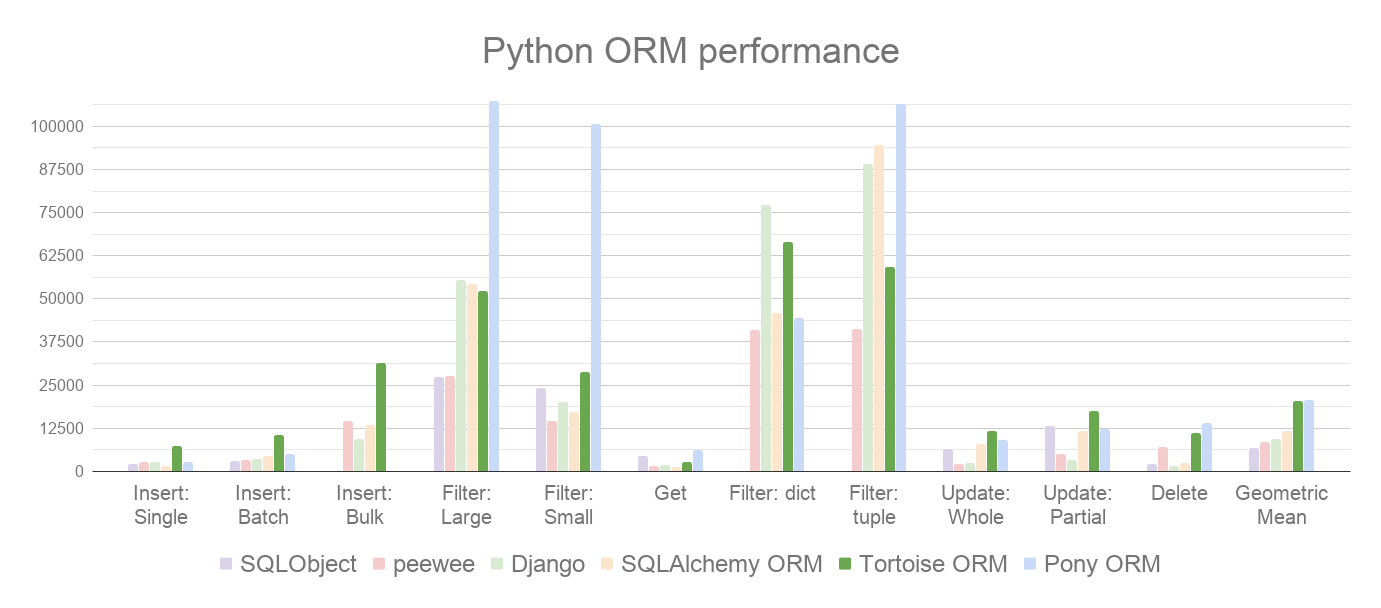Tortoise ORM
Introduction
Tortoise ORM is an easy-to-use asyncio ORM (Object Relational
Mapper) inspired by Django.
You can find the docs at Documentation
:::: note ::: title Note :::
Tortoise ORM is a young project and breaking changes are to be expected. We keep a Changelog and it will have possible breakage clearly documented. ::::
Tortoise ORM supports CPython 3.9 and later for SQLite, MySQL, PostgreSQL, Microsoft SQL Server, and Oracle.
Why was Tortoise ORM built?
Tortoise ORM was built to provide a lightweight, async-native Object-Relational Mapper for Python with a familiar Django-like API.
Tortoise ORM performs well when compared to other Python ORMs. In our benchmarks, where we measure different read and write operations (rows/sec, more is better), it's trading places with Pony ORM:
How is an ORM useful?
An Object-Relational Mapper (ORM) abstracts database interactions, allowing developers to work with databases using high-level, object-oriented code instead of raw SQL.
- Reduces boilerplate SQL, allowing faster development with cleaner, more readable code.
- Helps prevent SQL injection by using parameterized queries.
- Centralized schema and relationship definitions make code easier to manage and modify.
- Handles schema changes through version-controlled migrations.
Getting Started
Installation
The following table shows the available installation options for different databases (note that there are multiple options of clients for some databases):
Database Installation Command
SQLite pip install tortoise-orm
PostgreSQL (psycopg) pip install tortoise-orm[psycopg]
PostgreSQL (asyncpg) pip install tortoise-orm[asyncpg]
MySQL (aiomysql) pip install tortoise-orm[aiomysql]
MySQL (asyncmy) pip install tortoise-orm[asyncmy]
MS SQL pip install tortoise-orm[asyncodbc]
Oracle pip install tortoise-orm[asyncodbc]
: Available Installation Options
Quick Tutorial
Define the models by inheriting from tortoise.models.Model.
from tortoise.models import Model
from tortoise import fields
class Tournament(Model):
id = fields.IntField(primary_key=True)
name = fields.CharField(max_length=20)
class Event(Model):
id = fields.BigIntField(primary_key=True)
name = fields.TextField()
tournament = fields.ForeignKeyField('models.Tournament', related_name='events', on_delete=fields.OnDelete.CASCADE)
participants = fields.ManyToManyField('models.Team', related_name='events', through='event_team', on_delete=fields.OnDelete.SET_NULL)
class Team(Model):
id = fields.UUIDField(primary_key=True)
name = fields.CharField(max_length=20, unique=True)
After defining the models, Tortoise ORM needs to be initialized to
establish the relationships between models and connect to the database.
The code below creates a connection to a SQLite DB database with the
aiosqlite client. generate_schema sets up schema on an empty
database. generate_schema is for development purposes only, check out
aerich or other migration tools for production use.
from tortoise import Tortoise, run_async
async def init():
# Here we connect to a SQLite DB file.
# also specify the app name of "models"
# which contain models from "app.models"
await Tortoise.init(
db_url='sqlite://db.sqlite3',
modules={'models': ['app.models']}
)
# Generate the schema
await Tortoise.generate_schemas()
run_async(main())
run_async is a helper function to run simple Tortoise scripts. Check
out Documentation for FastAPI, Sanic and
other integrations.
With the Tortoise initialized, the models are available for use:
async def main():
await Tortoise.init(
db_url='sqlite://db.sqlite3',
modules={'models': ['app.models']}
)
await Tortoise.generate_schemas()
# Creating an instance with .save()
tournament = Tournament(name='New Tournament')
await tournament.save()
# Or with .create()
await Event.create(name='Without participants', tournament=tournament)
event = await Event.create(name='Test', tournament=tournament)
participants = []
for i in range(2):
team = await Team.create(name='Team {}'.format(i + 1))
participants.append(team)
# One to Many (ForeignKey) relations support creating related objects
another_event = await tournament.events.create(name='Another Event')
# Many to Many Relationship management is quite straightforward
# (there are .remove(...) and .clear() too)
await event.participants.add(*participants)
# Iterate over related entities with the async context manager
async for team in event.participants:
print(team.name)
# The related entities are cached and can be iterated in the synchronous way afterwards
for team in event.participants:
pass
# Use prefetch_related to fetch related objects
selected_events = await Event.filter(
participants=participants[0].id
).prefetch_related('participants', 'tournament')
for event in selected_events:
print(event.tournament.name)
print([t.name for t in event.participants])
# Prefetch multiple levels of related entities
await Team.all().prefetch_related('events__tournament')
# Filter and order by related models too
await Tournament.filter(
events__name__in=['Test', 'Prod']
).order_by('-events__participants__name').distinct()
run_async(main())
Learn more at the documentation site
Migration
Tortoise ORM uses Aerich as its database migration tool, see more detail at its docs.
Contributing
Please have a look at the Contribution Guide.
ThanksTo
Powerful Python IDE Pycharm from Jetbrains.
License
This project is licensed under the Apache License - see the LICENSE.txt file for details.


